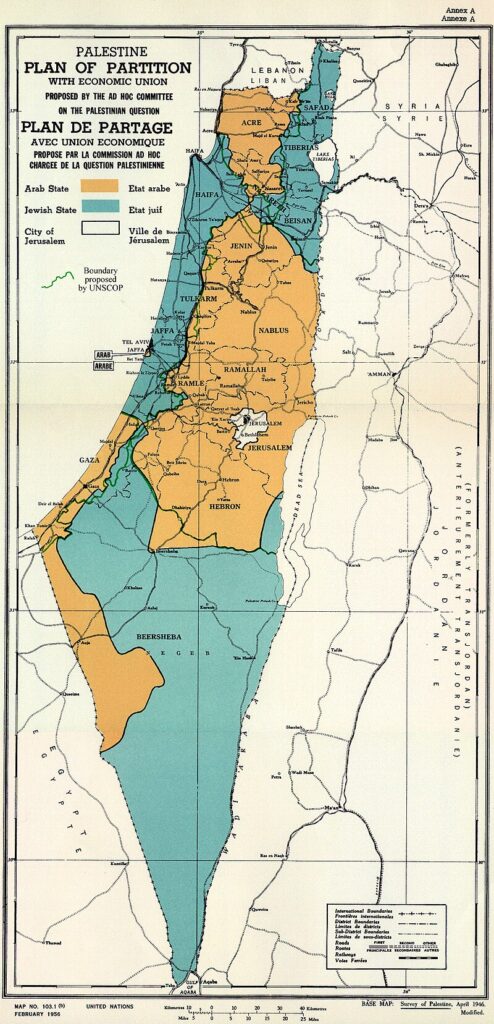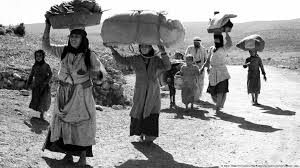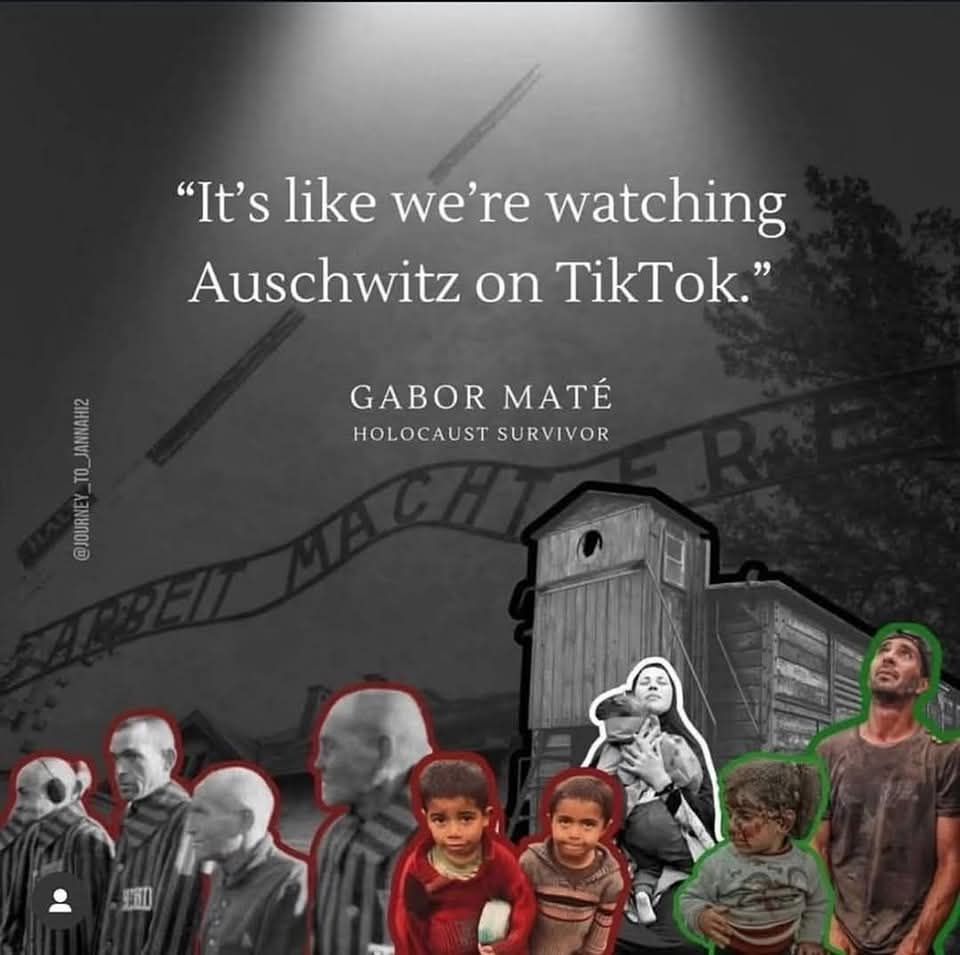To device a solution, it is necessary first to define the problem, and to do that we must go back in time to the origin of the problem. So we will start this analysis with a brief history of the events that led us to were we are today.
Palestine as a British Protectorate
As a consequence of the fall of the Ottoman Empire after the second world war, Palestine became a British Protectorate from 1917 to 1947. The British ruled over Palestine with harsh methods, like they did in India and other parts of the British empire. So when the indigenous population revolted in 1936 to fight for the country’s independence, the uprising was brutally repressed by the British military and police forces, resulting in an estimated 10 percent of the adult male Palestinian Arab population either killed, wounded, imprisoned or exiled. Another result of the unsuccessful revolt was that it caused the British Mandate to give crucial support to pre-state Zionist militias like the Haganah, which received military training from the British that benefited them later in the ethnic cleansing of the indigenous population from Palestine in 1947 and subsequent war against the Arab League in 1948.
Jewish Mass Emigration to a Zionist Settler Colonial Project in Palestine
As Jews were being expelled from Europe in the beginning of the 20th century, especially from Russia and Eastern Europe, western European countries and the US started to impose restrictions on Jewish immigration. At the same time Jews were encouraged to emigrate to Palestine. The British Foreign Secretary Arthur Balfour, author of the Balfour Declaration announcing in 1927 Britain’s support for the establishment of a “national home for the Jewish people”, was also a fervent antisemite who in his time as prime minister passed legislation (the Aliens Act in 1905) restricting Jews from entering Great Britain. Balfour had personally delivered passionate speeches about the imperative to restrict the wave of Jews fleeing the Russian Empire from entering Britain. Balfour’s and Britain’s support for the new Zionist settler colonialist project in Palestine must be seen in the light of these historical facts, not the least because it shows that Zionism and Antisemitism coexisted from the very beginning.
Being barred from entering Britain, USA and many other western countries, Jewish refugees started to emigrate in large numbers to Palestine, where there were no restrictions on immigration and they were welcomed by a fast growing Jewish expat community.
The Ethnic Cleansing of Palestinians: The Nakba
The Nakba, which means “catastrophe” in Arabic, refers to the mass displacement and dispossession of Palestinians, from December 1947 through 1948, during the Arab-Israeli war. Before the Nakba, Palestine was a multi-ethnic and multi-cultural society where Muslims, Christians and Jews with a few historical exceptions lived peacefully together for several centuries. However, the conflict between Arabs and Jews intensified in the 1930s with the steep increase in Jewish immigration and with the Zionist movement aiming to establish a Jewish state in Palestine.
Having heard horror stories from Europe, many Palestinians had sympathy for the arriving Jewish refugees fleeing from the Nazi regime in Germany, and took them in to live with them in their own homes. For a while Jewish immigrants bought land for their communities, but as the inflow of new refugees increased, as the Zionist idea of a Jewish majority state took hold, and as the military capacity of the Jewish minority increased, the idea of “capturing” land rather than buying land became more prevalent.
As World War 2 ended, a fatigued Britain toned down its imperial ambition, pulled out of India and decided to leave the “problem of Palestine” to the newly established United Nations, which at the time consisted of 51 nations. UN devised a Partition Plan for Palestine documented in its Resolution 181 on December 2nd 1947. The plan was for a partition into two independent states, a Jewish state comprising of 56.47 percent of the land, and an Arab state comprising of 42.88 percent of the land, with a special regime for the city of Jerusalem. People could decide which state they wanted to live in and move to that state, but no one should be forcibly displaced, and religious preferences should be respected regardless of in which state one wished to live. As we now know, this plan was never to be realised.

The Palestinians rejected the partition plan which would leave them with less than half of their original territory and give most of their land to a Jewish minority of around 33 percent of the population, a large part of whom were recent immigrants. The Jews also rejected the partition plan, though not formally. Instead, Jewish militias started massacring Palestinian villages and cities to drive the indigenous population out in order to create a Jewish majority by diminishing the Arab populace. The massacres were conducted by the Jewish terrorist militias Irgun, Lehi and Haganah (which turned to terrorism after1945), and the first of a series of massacres to follow took place in Tirat Haifa, which was attacked by Irgun on December 11th 1947, just a few days after the UN Partition plan was announced. Wikipedia lists 48 such massacres and more than 400 villages that were emptied of non-Jews and mostly destroyed. The major Palestinian cities of Jaffa and Haifa were also subject to terrorism and violent expulsion of around 60-70 000 Palestinians each.
The Israeli historian Ilan Pappé gives a thorough presentation of the Nakba in his book “The Ethnic Cleansing of Palestine”. About 750 000 people, which amounted to two thirds of the non-Jewish population, were displaced in this period. The expulsion was exceptionally cruel – the Jewish militias would come at night, attach explosives to selected houses and blow them up with whole families sleeping inside them. Men down to teenagers were rounded up and summarily executed, women and girls down to the age of 16 years were raped, and those who survived had to give up their personal belongings, including jewellery and cash, before being forced at gunpoint onto buses and dumped in Gaza or sent walking, often barefoot, in the direction of the nearest border. Thus most of the refugees ended up in Jordan, Lebanon and Gaza. Mass graves were paved over and forgotten, destroyed villages were planted with imported pine trees, and Hebrew place names replaced the original Arabic place names.

The Israeli authorities have gone to great length to eradicate any trace of the Nakba, including prohibiting the use of the term in school text books and academic discourse. The Palestinians, however, have not forgotten The Catastrophe. Those who fled carried with them the keys to their homes, hoping one day to return, not knowing that the Israeli authorities made sure this would never happen, instead distributing their homes, furniture and personal belongings to Jewish immigrants.
Further expulsion of Palestinians in the 1967 War
In the 1967 war, Israel occupied the entire territory of historical Palestine (and in addition areas in neighbouring Arab states). There was a second great exodus of Palestinian refugees – almost half a million. By 1970, according to expert demographic estimates, of about 3 million Palestinians, less than half lived within the borders of Palestine – about 400,000 as Israeli citizens, and about a million as inhabitants of the “occupied territories” of the West Bank and Gaza. Of the remaining 1,6 million, about 800,000 were in Jordan, 600,000 in Syria and Lebanon, and the remaining 200,000 scattered in other countries.
International Law, the UN and the Right of Return
Based on a draft resolution presented by Great Britain, the United Nations General Assembly on 11 December 1948 passed resolution 194 (III) which, in paragraph 11, categorically declared:
“… that the refugees wishing to return to their homes and live at peace with their neighbours should be permitted to do so at the earliest practicable date, and that compensation should be paid for the property of those choosing not to return and for loss of or damage to property which, under principles of international law or in equity, should be made good.”
The UN further published a report in 1978 on the Right of Return of the Palestinian People, where it reiterated this right and also included the 300 000 Palestinians that were expelled from their homes in the 6-days war in 1967.
Diaspora advocacy has kept the Palestinian right of return alive in global discourse. The UK-based Palestinian Return Centre, for instance, has campaigned relentlessly for refugee rights, gaining special consultative status with the UN Economic and Social Council in 2015. Meanwhile, the Global Campaign to Return to Palestine, operating across forty-five countries, drives worldwide events to ensure the issue remains on the international agenda. These efforts ensure the right of return remains not just a memory but a movement.
The state of the Palestinian Population in 2025
There are around 3 million Palestinians living in the West Bank and around 2 million Palestinians living in Gaza. In addition there are about 6.1 million members of the Palestinian Diaspora in 2025, most of whom live in Jordan (3.2 million), Syria (630 000), Lebanon (400 000), and Chile (500 000).
Most of the population of Gaza are descendants of refugees from the massacres and forcible expulsions of 1948 and 1967. Gaza, which is about the size of East London or Oslo, is one of the most densely populated areas in the world – more densely populated than Tokyo. Israel controls its land borders, its sea borders, its air space and electronic space, and has established an elaborate system of surveillance of its population. Israel controls what goes into Gaza and what goes out of Gaza. Gaza has therefore been described as the World’s Largest Open Air Prison, in later years as an Open Air Concentration Camp, and since the beginning of what the ICJ in 2024 denoted as a “Plausible Genocide”, an Open Air Death Camp.
Humanitarian organisations with a presence inn Gaza had for decades warned Israel that Gaza had become a pressure cooker that could explode any moment. Still, when the “explosion” occurred on October 7th 2023, Israel was taken completely by surprise.
October 7th 2023 and the following “Plausible Genocide”
 It is impossible to know what exactly happened during the “Al-Aqsa Flood” operation conducted by 6 different Palestinian resistance organisations followed by between one and two thousand civilians when they breached the prison fences of Gaza on October 7th 2023. What we do know is that the Israeli authorities have lied extensively about what happened – propagating made up stories of 40 beheaded babies, babies in ovens, babies hanging from clothes lines, babies cut from their mothers’ wombs etc – all later debunked. One baby was actually killed on that day, 9 month old Mila Cohen. An unborn baby also died after being shot in the leg through her mother’s body. 1139 people were killed altogether on that day, of which around 300 were Israeli soldiers. We also know that the so called “Hannibal Directive” was applied on several instances that day, with explicit orders that no vehicle carrying hostages should be allowed to enter Gaza. Israeli helicopters and tanks fired on cars and houses, killing both Palestinians and Israelis. How many Israelis that were killed by “friendly fire” remains unknown since Israeli authorities refuse to disclose the number. The fact that it is being kept secret makes it reasonable to conclude that the actual number is substantial. 70 burned out cars from the attacked music festival and several destroyed buildings adds to this, as the attacking Palestinians mostly were armed with light weapons unable to cause material damage on this scale.
It is impossible to know what exactly happened during the “Al-Aqsa Flood” operation conducted by 6 different Palestinian resistance organisations followed by between one and two thousand civilians when they breached the prison fences of Gaza on October 7th 2023. What we do know is that the Israeli authorities have lied extensively about what happened – propagating made up stories of 40 beheaded babies, babies in ovens, babies hanging from clothes lines, babies cut from their mothers’ wombs etc – all later debunked. One baby was actually killed on that day, 9 month old Mila Cohen. An unborn baby also died after being shot in the leg through her mother’s body. 1139 people were killed altogether on that day, of which around 300 were Israeli soldiers. We also know that the so called “Hannibal Directive” was applied on several instances that day, with explicit orders that no vehicle carrying hostages should be allowed to enter Gaza. Israeli helicopters and tanks fired on cars and houses, killing both Palestinians and Israelis. How many Israelis that were killed by “friendly fire” remains unknown since Israeli authorities refuse to disclose the number. The fact that it is being kept secret makes it reasonable to conclude that the actual number is substantial. 70 burned out cars from the attacked music festival and several destroyed buildings adds to this, as the attacking Palestinians mostly were armed with light weapons unable to cause material damage on this scale.
The pilots fired on the fence, and also right inside the settlements. The pilots received information from the ground on mobile phones. In 4 hours, about 300 targets were attacked
Translated from the Israeli Hebrew Newspaper/Website Ynet
As of March 27th 2025 more than 50 000 identified Palestinians have been killed in Gaza, and it is estimated that the actual number of deaths exceeds 200 000. Around 60 percent of the killed are women and children, and doctors from all over the world working as volunteers in Gaza’s hospitals report that preteen children are committed daily with bullet wounds to their heads and chests – killed or lethally wounded by Israeli snipers.
The 2 million or so left of the civilian population of Gaza are being herded from the North of Gaza to the South and back again like cattle, and more than 90 percent of the area’s infrastructure is now more or less completely destroyed, including arable land, roads, houses and buildings, universities, schools and hospitals. The main question now is: With Gaza made unlivable, where can the population go?
The One State Solution

Israel has inadvertently created a situation where the 2 million inhabitants of Gaza have nowhere left to go — except back to their original homes in Israel. This is now the only possible solution, short of bombing or starving 2 million people to death. Israel will have no other choice but to tear down the fences and let the indigenous population back into its country. And as it happens – this was always not only the best solution, but arguably the only solution that can guarantee lasting peace and security for both the Jewish and the Muslim and the Christian population.
Jews, Muslims and Christians lived in peaceful coexistence for centuries before the Zionist settler-colonial project introduced the construed idea of a “pure” Jewish state contingent on a mandatory Jewish majority. And it can happen again. When Jews today can live in peace in Germany, of all places, reconciliation must be possible i Israel/Palestine as well. This makes sense on many levels – The Two State Solution has been vehemently opposed by Israel since 1947, and the area left for a separate Palestinian state is now nominal, making room only for small scattered “Bantustans”. The One State Solution, on the other hand, based on the principle of equal rights for all citizens, proposes a single democratic state encompassing Israel, the West Bank, East Jerusalem, and Gaza, in which all citizens exercise their rights and fulfil their responsibilities as equal members of society.
This also aligns well with what PROUT considers sound principles for creating viable and sustainable Socio-Economic Units or in 20th century parlance: Nation States, which are: Shared economic problems, uniform economic potentialities, ethnic similarities, common sentimental legacy and similar geographical features. Palestinians and Jews are both semites that share a common history. Many, if not most of the Palestinians of today are descendants of Jews who converted to Islam, and to a much lesser degree, to Christianity. The Ottoman Empire gave substantial tax reductions for Muslims, spurring large conversions from Judaism to Islam. (Ottoman Jews were obliged to pay several special taxes to the Ottoman authorities. These taxes included the cizye (or jizya), the ispençe, the haraç, and the rav akçesi (“rabbi tax”).)
What are the chances for a One State Solution?
The establishment of one secular democratic state with equal rights for all citizens “From the River to he Sea”, comprising the current Jewish, Christian and Muslim population may seem far fetched, or even impossible today, and in order for a One State Solution to win acceptance, a radical change of the Israeli regime and ideology must take place. This will most probably be effected by what Proutists like to call “Circumstantial Pressure”, caused for example by the otherwise insolvable humanitarian situation in Gaza.
German Proutists marched the streets of German cities in the mid 1980s demonstrating for a United Germany. Mostly, they were laughed off the streets. As if the Soviet Union would ever let that happen! East Germany was cemented as a part of the Eastern Block, and Western Germany formed an integral part of the Western Block, and ne’er the two should meet. If anyone, at that time, had suggested that the Soviet Union a couple of years later would abandon Communism and disintegrate into different autonomous countries, they would most certainly have become the laughing stock of the day. And yet, that is exactly what happened. And this is why we should never give up fighting for the best solution for the Jewish and Arab population of Palestine.
REFERENCES
List of villages depopulated during the Nakba:
Link to the UN Report on the Right of Return of the Palestinian People:
https://www.un.org/unispal/document/auto-insert-210170
Link to the 1947 UN Partition Plan for Palestine
https://digitallibrary.un.org/record/667161?v=pdf
Link to description of PROUT’s criteria for the formation of socio-economic units:
https://proutglobe.org/2011/06/criteria-for-socioeconomic-groupification/